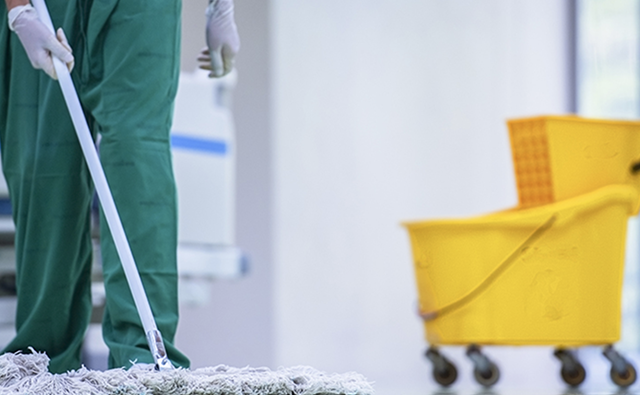Industry News, HI&I Cleaning Care
Floor Hygiene and the Under-Studied Risk of Pathogen Dissemination

Industry News, HI&I Cleaning Care

The copyright of the article featured picture belongs to Clean Middle East.
While environmental surfaces that receive frequent hand contact (i.e. high touch surfaces) are understood to be a potential vector for certain environmentally transmissible pathogens, floors are not generally considered to contribute to the risk of pathogen dissemination similarly, nor the associated infection risk, whether in healthcare settings or other facilities. As a result, floor hygiene is frequently ignored or at best considered of low importance when assessing the risk of transmission for certain environmentally transmissible pathogens.
Governmental guidelines similarly associate minimal risk with floors, advising facilities to regularly clean floors, but do not identify infection risks associated with floors and do not advise the use of sanitizers or disinfectants.
Research in the last decade and evolving thinking is starting to paint a clearer picture of how floors act as a reservoir and may contribute to infection risk. While the evidence is far from compelling at this point, it is consistently pointing in the direction of floors potentially playing a role in pathogen dissemination, especially in healthcare facilities.
To establish the potential risk of floors in contributing to infection risk, floors need to be shown to be a reservoir for pathogenic microorganisms and modes of transmission need to be established that can result in the movement of an infectious dose of pathogenic organisms to a susceptible host through a portal of entry.
The strongest evidence for the potential role of floors in the transmission of pathogens leading to human infection comes from a series of recent studies. Epidemiological models based on studies of air movement have established a framework for understanding how pathogenic microorganisms move from the floor to off the floor surfaces where hand contact can occur (Wei, 2016). Studies of floors that were intentionally seeded with non-pathogenic viruses demonstrated that these viruses can move from floors to hand contact surfaces in the same patient room and other rooms on the same ward (Koganti, 2016), demonstrating the potential for transmission.
Testing of surfaces in several studies have shown that transfer of pathogenic bacteria from floors to the patient bed does occur in certain circumstances (Galvin, 2016) (Mahida, 2016). However the subsequent link to causing human infection has not been demonstrated so far.
In understanding the potential role of floors in the chain of infection, it is important to understand how their role is currently classified in a high-risk environment, such as a healthcare facility. According to the Spaulding hierarchy, noncritical surfaces in a healthcare facility are those that may come in contact with intact skin but do not come in contact with mucous membranes, open skin, or sterile body sites (Rutala, 2008). Floors, which presumably only contact footwear and intact skin when people walk barefoot on the floor, thus would meet the definition of a noncritical surface (Rutala, 2008).
The CDC views floors as of minor importance in contributing to patient infections and environmental hygiene guidance documents for healthcare facilities.
The evidence of floor contamination with pathogenic organisms is strong and a number of studies have demonstrated that floors are typically contaminated with bacteria and frequently contamination with healthcareassociated infection (HAI) causing pathogens including MRSA, VRE, and Clostridioides difficile (C. difficile).
Several studies have included an investigation of whether pathogens can be transferred from floors to other surfaces. In the 5 hospital study by Deshpande (2017), the authors assessed objects coming in contact with floors in 100 surveyed patient rooms and found that 41% of these patient’s rooms had objects in contact with the floor that would also be touched by the patient or healthcare workers’ hands. These objects included personal items, medical devices, and bed linens or towels. On finding such objects on the floor in a patient room, the auditor lifted the object off the floor with either their hand or a sterile glove and then swabbed the hand/glove to show whether bacterial transfer could occur.
They found a high rate of contamination with hands/gloves positive for MRSA (18%), VRE (6%), and C. difficile (3%), demonstrating the potential for dissemination of pathogens from the floor.
Studies investigating air movement and floors In addition to studies showing the potential for surface to hand to surface transfer (indirect contact transmission), the role of air in contributing to pathogen dissemination has also been investigated. Wei (2016) discussed how breathing, talking, sneezing, and coughing can expel respiratory droplets containing respiratory viruses into the environment and how these droplets can move >6 meters when expelled at high velocity and ultimately the droplets tend to settle on horizontal hand contact surfaces or the floor.
Airborne droplets of sufficient size (>5 microns) will rapidly settle onto surfaces, including the floor and smaller droplets (<5 microns) and can be disseminated by air movement before eventually settling onto environmental surfaces over a larger distance. ><5 microns) and can be disseminated by air movement before eventually settling onto environmental surfaces over a larger distance.
Taken together, several studies provide limited evidence that dust on the floor can be disturbed by walking, which can re-disperse dust containing bacteria into the air. Once airborne, the dust particles can move into the breathing zone to be inhaled or swallowed, or settle onto hand contact surfaces. Studies demonstrating the link between pathogens on the floor and resuspension leading to human infection are needed to determine the relative level of risk associated with this series of events.
Diversey has consistently been updating its floor hygiene solutions with emerging scientific research. This reflects in all their product ranges across a vast variety of facilities, including healthcare.